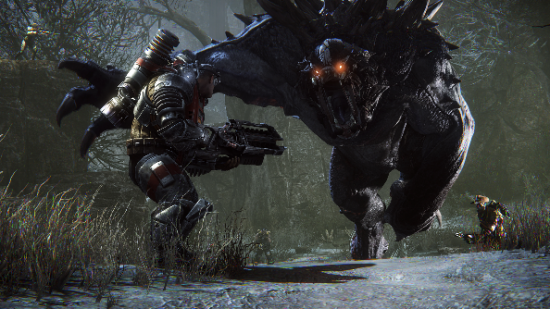Left 4 Dead’s brand of four-friends-vs-everything has never quite been replicated by anyone else. And that’s still true: whilst Evolve is a new spin on that formula, it has been created by Turtle Rock: the very same studio who first created Left 4 Dead. But what they’ve created in Evolve, despite being clearly influenced by beats of Left 4 Dead’s design, is a new and intriguing oddity.
It’s still a four-player co-op game where friends or strangers run their way through large maps, but instead of hordes of zombies there’s just one enemy: the monster. This brute is played by another player, and must be eliminated by the hunters before he gobbles them all up for dinner.
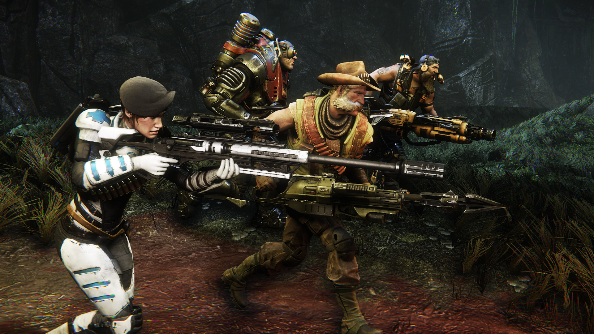
At the very centre of Evolve are the game’s classes or ‘hunters’: Assault, Trapper, Medic, and Support. Each class has three unlockable characters, each with their own unique loadout. Unlike a game like Battlefield, where all classes essentially do the same thing (kill stuff) and then have a secondary ability that makes them useful, Evolves classes are all built to fulfil very specific purposes. Assault is the damage guy; he’s got two massive guns that pump out pain, and grenades that can really mess up a monster’s morning. Everyone else comes with a gun, but it’s really only the Assault that deals much pain. You can’t play with a team of duplicate classes either; there must be one of every type of hunter in a match, so don’t go thinking about sending in an army of Assaults.
Leading the team is the Trapper. Depending on which Trapper character you play as depends on your tools, but all of them have a gadget that allows them to track the monster’s movements. My personal favorite gizmo is Daisy; an alien scent hound that will sniff out the monster’s tracks and howl as you gain upon it. When you finally come upon the monster, the Trapper’s role switches to locking the monster in place. You can erect a massive force field up around the immediate area to stop the beast from running away, and then tether the thing in place using harpoons so everyone can start unloading on it.
The final two classes are much more support-oriented. The Medic is a sniper-style class with the ability to heal and resurrect other hunters. One of the characters comes with a handy tranquiliser gun that makes the monster all woozy and glow yellow for other hunters to see. The Support offers a much more varied collection of buffs, be that automated sentry turrets that zoom around the monster’s head, shields for other hunters, or a bomb that detonates in a cloud of dust that coats your target and allows you to track it through walls.
With such distinct class roles, it becomes important to play what you select. It’s always necessary to shoot at the monster when you can, but a Trapper needs to be focused on keeping the monster cornered and locked down, and the Support should be buffing every team member at every available moment. Leave the damage dealing to the Assault, and join in the slaughter when you’ve got your own tasks done. When players work with their class selection’s strengths, the team of hunters becomes a force that can quite easily take on a monster.
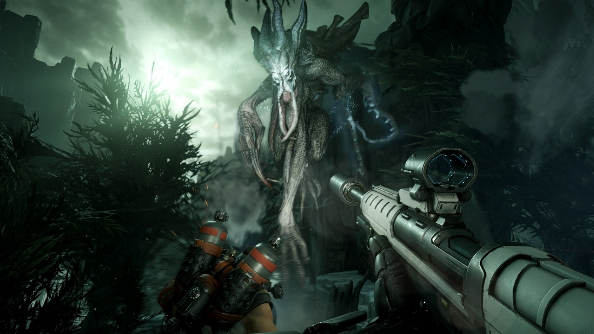
As the monster you’ve got no buddies, but you can do that fancy trick in the title: evolve. Eat enough of the local wildlife and you can upgrade yourself into a new, stronger form. Each evolution – there are three stages – allows you to put three extra points into your abilities, and generally makes you bigger, stronger, and meaner. Evolving is vital: not only do you become more difficult to kill at higher evolution stages, but you need to be at stage three in order to complete objectives in certain game modes.
Actually making it far enough through a match to evolve can be tricky. At stage one you’re remarkably squishy, and so are on the run from the hunters from the very get go. You’ll spend much of the early match stealthily crawling through the undergrowth, snatching unaware animals for a quick meal, and constantly sniffing the air to find out where the hunters are. If the team are closing in on you, you’ll have to run, giving an odd kind of survival aspect to the monster’s experience. It’s not what you expect; it’s easy to assume the monster will just be about raging around like the Incredible Hulk, but there’s more nuance to it. It’s almost like channeling an Attenborough documentary; become one with nature and the food chain before gaining strength and taking the fight to your predators.
Evolve currently has three different beasts: the Goliath, the Kraken, and the Wraith. To play as, they’re all distinctly different. The Goliath is all about rage: hurling rocks, smashing things with your fists, and breathing fire everywhere. The Kraken can fly, so has much better options when it comes to positioning and attack angles, and fights with great bolts of searing lightning. The Wraith is the most slippery, able to zip around the map and abduct hunters, and disappear in a burst of glitter. They unlock sequentially, so you’ll have to play as the Goliath for a while first, but it’s easy enough to get access to the other two. They’re more distinct to play as than to fight though; as a hunter, it doesn’t really matter what you’re fighting: they’re all big, nasty, and require a lot of shooting.
That’s perhaps one of Evolve’s biggest problems. As a hunter, all the monsters kind of feel the same. Your tactics for one will work almost identically against another, and the crux of how well you do will always be how many bullets you can cause to hit target. Each monster doesn’t have a specific weakness to exploit; they’re all bullet sponges. Trap it, shoot it, kill it. If the act of this method wasn’t so well constructed, Evolve’s battles could have been in danger of being quite boring. Thankfully, getting a monster just where you want it and blasting the hell out of it is always giddy fun.
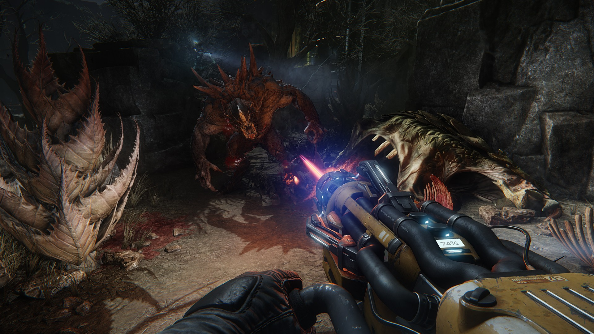
Killing the monster isn’t the core of all of Evolve’s modes, but it’s what it does best. Hunt simply see’s hunters chase down and kill it before it can evolve to stage three and destroy a generator. Nest asks hunters to locate six monster eggs and destroy them. The monster must protect them, and has the option of hatching them to provide back-up in the form of mini-monsters. Rescue provides a similar experience, with the hunters trying to find and save stranded survivors while the monster seeks them out and eats them. Defend is the most unusual of Evolve’s mode, asking the hunters to remain fairly stationary and defend a set of generators at a base whilst the monster assaults them with help from minions. These additional objectives provide focus, but they don’t hold up quite as well as the game’s signature Hunt.
Each mode can be played individually, or sewn together as part of a mini-campaign called Evacuation. This puts you through five different matches, with each result impacting the overall campaign. Winning a match will allow the hunters a buff in the next match, for example gun turrets coming online to automatically shoot the monster. Failing provides the monster a helping hand: in one map you’ll have to defend a laboratory where a Wraith is being experimented on. Let the monster trash the lab, and in the next map he’ll be able to use portals generated by the Wraith to quickly teleport around the area.
After finishing a map in Evacuation, you’ll be provided with two options for the next map, which allows an even selection of Hunt, Nest, and Rescue games to be played. The fifth and final map will always be a Defend match, which – like Left 4 Dead’s campaigns – always offers up a frenetic and spectacular conclusion to the campaign.
The main problem that both Evacuation and quick skirmish games have is that the map design feels broadly the same across the board. There’s maps with power generators in, one with a lab in, but overall they all feel like the same rock-and-tree filled forests. All the maps are set on the same planet, so it’s understandable that they have some distinct character to link them all together, but they feel completely indistinguishable from each other. You don’t learn the maps easily; you won’t have that special place you always know to use to create a perfect trap point, or know the one-true sniper’s nest. It all just feels very much the same, which denies each map an awful lot of character.
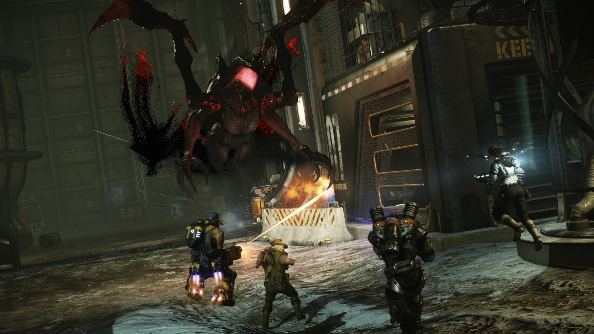
What the maps lack in visual design is made up in functionality, though. There’s great amounts of verticality, which monsters can easily climb and bound across, and hunters can navigate with jetpacks. The rocky terrain has plenty of hidey holes and undergrowth to use as camouflage. There’s also plenty of wildlife, and killing special creatures offers a buff, creating a MOBA-like ‘jungling’ element. This contributes to making the world of Shear feel as hostile as the monsters it’s harbouring.
It’s important to note that all of Evolve’s modes can be played online or solo. Bots will replace disconnected players, or take on the role of other hunters and the monster in solo games. The AI is functional, knowing what tricks to use and when to help you out of a sticky situation, but teamwork is difficult with hunters you can’t collaborate with. You can swap between any of the hunters on the fly to ensure the best tactics are being used from moment-to-moment, but generally the monster has the upper hand in solo games, so offline play is for the odd game only. You do gain XP and unlocks in both modes though, so offline is most certainly not just a ‘practice’ arena.
Let’s talk about DLC. There’s £70 worth of DLC out there right now, and more to come. They’re pretty much all skins, but it’s absurd that painting your monsters in red stripes can cost as much as £6. The Hunting Pass offers more: four new hunters when they’re released, and skins for the monsters, for a staggering £19.99. The game’s characters are so well rounded though that unlocking new hunters doesn’t actually provide you with a more powerful experience, just a different approach. As such I don’t think new hunters will actually add that much, never mind be worth twenty quid. Similar sentiments apply to the forthcoming Behemoth monster, too. Therefore I’m actively suggesting you don’t buy any of this DLC. The most important content to longevity – new maps and modes – will be provided free of charge, and that’s all you should be interested in.
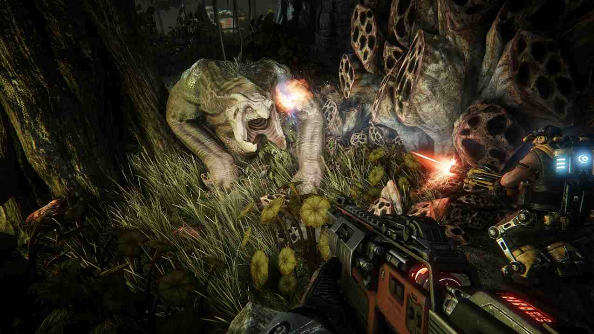
For performance tests I played Evolve on a PC powered by an Intel i7 3770k coupled with a single AMD HD7970 GPU. Despite feedback being negative during the beta tests, Evolve ran without a hitch on my system, maintaining steady framerates at various graphics settings. Networking worked fine too, with no lag or connection problems. As far as options go, Evolve is very thin on the ground, just offering resolution, texture, and anti-aliasing options. No FOV options is sorely missed.
Evolve is really good fun. With its four-player co-op matches sharing so much base DNA with Left 4 Dead, it’s great that it feels like something completely different. It still shares that pace – extended moments of quiet followed by massive bursts of excitement – but provides it in a very different manner. There’s not a huge amount of content in Evolve compared to many unlock-led games, but by keeping things tight the game always stays focussed on what’s important: the thrill of the hunt. The almost absence of variety in the map design may well hack down Evolve’s lasting appeal, but what’s here in the main game is perfect for many great hours.
